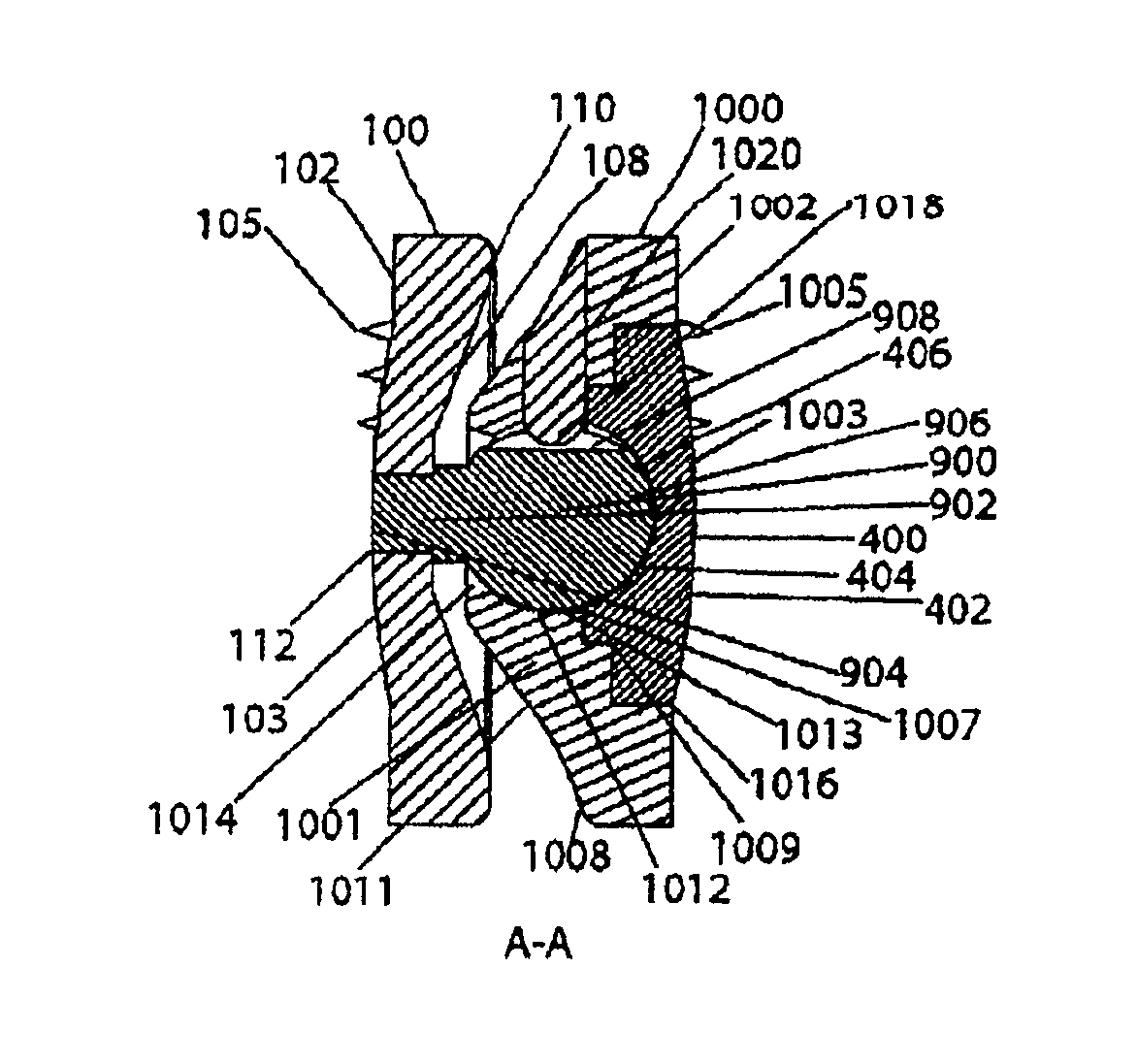Artificial intervertebral disc
a technology of artificial vertebrae and discs, applied in the field of bone and connective tissue of the disc, can solve the problems of collateral injury to the patient's spine, restrict the overall flexibility of the spinal column, and constrain the normal motion of the patient, so as to prevent the translation and separation of the baseplates
- Summary
- Abstract
- Description
- Claims
- Application Information
AI Technical Summary
Benefits of technology
Problems solved by technology
Method used
Image
Examples
first embodiment
[0106]A preferred embodiment of a first embodiment family of the present invention will now be described.
[0107]Referring to FIGS. 1a-c, a first baseplate 10 of a first embodiment family of the present invention is shown in top (FIG. 1a), side cutaway (FIG. 1b) and bottom (FIG. 1c) views. Also referring to FIGS. 1d-f, a second baseplate 30 of the first embodiment family is shown in top (FIG. 1d), side cutaway (FIG. 1e) and bottom (FIG. 1f) views.
[0108]More specifically, each baseplate 10,30 has an outwardly facing surface 12,32. Because the artificial disc of the invention is to be positioned between the facing surfaces of adjacent vertebral bodies, the two baseplates 10,30 used in the artificial disc are disposed such that the outwardly facing surfaces 12,32 face away from one another (as best seen in exploded view in FIG. 1g and in assembly view in FIG. 1h). The two baseplates 10,30 are to mate with the vertebral bodies so as to not rotate relative thereto, but rather to permit the...
second embodiment
[0122]A preferred embodiment of a second embodiment family of the present invention will now be described.
[0123]Referring to FIGS. 2a-c, a first baseplate 50 of a second embodiment family of the present invention is shown in top (FIG. 2a), side cutaway (FIG. 2b) and bottom (FIG. 2c) views. Also referring to FIGS. 2d-f, a second baseplate 70 of the second embodiment family is shown in top (FIG. 2d), side cutaway (FIG. 2e) and bottom (FIG. 2f) views.
[0124]With regard to the configuration of the convex structure in this second embodiment family, and the manner in which the ball is captured in the socket in this second embodiment family, the convex structure is configured as a non-flexible element that is integral with the second baseplate, and has the socket of the ball and socket joint at its peak. More clearly stated, the devices of this second embodiment family do not feature a flexible convex structure, and therefore (and also because of the manner in which the ball is captured in ...
third embodiment
[0129]Embodiments of the third embodiment family of the present invention will now be described.
[0130]With regard to the configuration of the convex structure in the third embodiment family, the convex structure is configured as a non-flexible element that is integral with the second baseplate, and has the socket of the ball and socket joint at its peak, similar to the configuration of the convex structure in the second embodiment family. In the preferred embodiment, the convex structure is shaped to have a curved taper.
[0131]With regard to the manner in which the ball is captured in the socket in the third embodiment family, the capturing is effected through the use of a solid ball. In order to permit the seating of the ball into the socket formed at the peak of the convex structure, the access hole in the second baseplate has a diameter that accommodates the diameter of the ball, and leads to the interior of the peak, which interior is formed as a concavity having an opening diame...
PUM
| Property | Measurement | Unit |
|---|---|---|
| rotation | aaaaa | aaaaa |
| perimeter | aaaaa | aaaaa |
| diameter | aaaaa | aaaaa |
Abstract
Description
Claims
Application Information
 Login to View More
Login to View More - R&D
- Intellectual Property
- Life Sciences
- Materials
- Tech Scout
- Unparalleled Data Quality
- Higher Quality Content
- 60% Fewer Hallucinations
Browse by: Latest US Patents, China's latest patents, Technical Efficacy Thesaurus, Application Domain, Technology Topic, Popular Technical Reports.
© 2025 PatSnap. All rights reserved.Legal|Privacy policy|Modern Slavery Act Transparency Statement|Sitemap|About US| Contact US: help@patsnap.com



